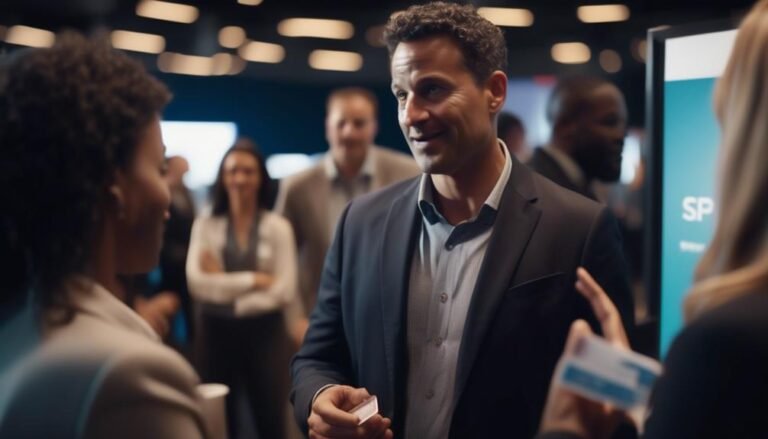How to Use LinkedIn for B2B Lead Generation
Have you ever wondered if LinkedIn truly holds the key to unlocking a wealth of B2B lead generation opportunities?
With its vast network of professionals and businesses, LinkedIn has become a powerhouse for connecting with potential clients and driving business growth. By strategically optimizing your profile, creating engaging content, and leveraging the platform's features, you can tap into a goldmine of leads waiting to be discovered.
But that's just the beginning. Let's explore the intricate strategies and tactics that can elevate your B2B lead generation game on LinkedIn.
Key Takeaways
- Optimize your LinkedIn profile with industry-specific keywords for better visibility.
- Craft compelling content using visuals, data insights, and interactive elements to attract leads.
- Engage with your target audience through personalized connections, valuable content, and thoughtful interactions.
- Share valuable insights, host webinars, and position yourself as a thought leader to drive B2B lead generation.
Optimizing LinkedIn Profile
To enhance your B2B lead generation efforts on LinkedIn, begin by optimizing your profile for maximum impact. Profile optimization is crucial for making a strong first impression on potential leads. Start by crafting a compelling headline that includes relevant keywords to increase your visibility in searches. Utilize a keyword strategy throughout your profile to attract the right audience. Incorporate industry-specific terms and phrases that your target leads are likely to search for.
Visual branding plays a significant role in capturing the attention of your audience. Ensure your profile photo is professional and aligns with your personal brand. A clear, high-quality image can help establish trust with potential leads. Additionally, consider customizing your background photo to further enhance your visual branding and showcase your expertise.
Crafting Compelling Content
Craft compelling content on LinkedIn by showcasing your expertise and providing valuable insights to attract and engage potential leads. To effectively engage your audience, consider the following strategies:
- Visual Storytelling: Utilize visually appealing graphics, images, and videos to tell a story about your brand or industry. Visual content tends to capture attention more effectively than plain text, making your posts stand out in the feed.
- Data-Driven Insights: Back up your claims and recommendations with data to establish credibility and show that your content is based on reliable information. Numbers and statistics can add depth to your posts and make them more compelling to your target audience.
- Interactive Content: Engage your audience by creating polls, quizzes, or interactive infographics. Encouraging participation can lead to increased engagement and help you gather valuable insights about your leads.
Engaging With Target Audience
When engaging with your target audience on LinkedIn, remember to focus on personalized connection requests to establish a genuine connection.
Share content that's relevant and valuable to your audience's interests, making them more likely to engage with your posts.
Implement thoughtful engagement strategies such as commenting on industry news or initiating conversations to foster relationships with potential leads.
Personalized Connection Requests
Engage your target audience effectively by sending personalized connection requests on LinkedIn. When crafting these requests, remember to:
- Personalize: Tailor your message to the recipient, mentioning a common interest or connection.
- Be Professional: Follow proper connection request etiquette by introducing yourself and explaining why you'd like to connect.
- Show Value: Highlight what value you can bring to them or how connecting can benefit both parties.
Relevant Content Sharing
To effectively engage with your target audience on LinkedIn, share relevant content that resonates with their interests and needs. Content curation is key to providing value to your connections.
By sharing insights and industry trends, you position yourself as a knowledgeable resource in your field. Utilize engagement tactics such as asking questions, conducting polls, or hosting webinars to spark discussions and interactions around the content you share.
When your audience finds your content valuable and engaging, they're more likely to view you as a thought leader and trust your expertise. Remember, the goal is to foster meaningful connections through the content you share, ultimately driving B2B lead generation.
Thoughtful Engagement Strategies
Implementing thoughtful engagement strategies is essential for effectively connecting with your target audience on LinkedIn and nurturing valuable relationships that can lead to successful B2B lead generation. To engage your audience effectively, consider the following tactics:
- Personalized Messaging: Tailor your messages to each prospect to show genuine interest and understanding of their needs.
- Ask Thoughtful Questions: Engage your audience by asking insightful questions that prompt discussions and showcase your expertise.
- Provide Value: Share valuable insights, resources, and industry updates to position yourself as a trusted source of information.
Building Strategic Connections
To maximize your B2B lead generation efforts on LinkedIn, targeting key decision-makers is paramount. By leveraging mutual connections, you can establish trust and credibility more easily.
Additionally, engaging with industry influencers can help expand your network and open doors to valuable opportunities.
Targeting Key Decision-Makers
How can you strategically connect with key decision-makers on LinkedIn to enhance your B2B lead generation efforts? Here are three essential tips to help you target key decision-makers effectively:
- Research and Identify: Utilize LinkedIn's advanced search filters to identify key decision-makers within your target industry. Look for individuals with relevant job titles or those who are actively involved in the decision-making process.
- Engage Thoughtfully: Once you've identified key decision-makers, engage with their content by liking, commenting, and sharing. Show genuine interest in their posts to start building rapport.
- Personalize Your Outreach: When reaching out to key decision-makers, tailor your messages to address their specific pain points and offer solutions that align with their business goals. Personalization can significantly increase your chances of getting a positive response.
Leveraging Mutual Connections
When it comes to leveraging mutual connections on LinkedIn for B2B lead generation, establishing strategic relationships with individuals who can introduce you to key decision-makers is crucial.
One effective way to do this is by forming referral partnerships with professionals in complementary industries. By collaborating with these partners, you can tap into each other's networks and gain access to a broader range of potential leads.
Additionally, attending networking events both online and offline can help you connect with individuals who may provide valuable introductions to key decision-makers.
Engaging With Industry Influencers
Engage with industry influencers strategically to elevate your B2B lead generation efforts. Industry thought leaders hold the key to expanding your reach and credibility. Here are three ways to leverage influencer partnerships and engagement strategies effectively:
- Build Genuine Relationships: Connect with industry influencers by engaging with their content, sharing valuable insights, and offering support.
- Collaborate on Content: Partner with influencers to create compelling content that resonates with your target audience, increasing your visibility and credibility.
- Attend Networking Events: Seize networking opportunities to meet influencers in person, fostering meaningful connections that can lead to mutually beneficial partnerships.
Leveraging LinkedIn Groups
To maximize your B2B lead generation efforts on LinkedIn, consider joining and actively participating in relevant LinkedIn Groups within your industry or target market. Group participation in these forums provides excellent networking opportunities, allowing you to connect with like-minded professionals, potential clients, and industry experts. Engaging in discussions, sharing valuable insights, and interacting with group members can significantly boost your visibility and credibility within your niche.
| Benefits of Leveraging LinkedIn Groups | ||||
|---|---|---|---|---|
| 1. Lead Generation | 2. Industry Insights | 3. Networking Opportunities | 4. Brand Exposure | 5. Collaboration Potential |
| Connect with potential leads | Stay updated on industry trends | Expand your professional network | Increase brand visibility | Find opportunities for collaboration |
| Share valuable content | Gain insights from industry experts | Engage with like-minded professionals | Showcase expertise | Collaborate on projects |
Utilizing Sales Navigator
Utilize Sales Navigator to enhance your B2B lead generation strategy on LinkedIn by leveraging advanced search filters and tailored insights for targeted prospecting. Sales Navigator offers powerful features that can help you identify and connect with potential leads more effectively.
Here are three key ways Sales Navigator can boost your lead generation efforts:
- Advanced Search Filters: Narrow down your search criteria based on industry, company size, job title, and more to pinpoint ideal prospects quickly and efficiently.
- Real-time Insights: Stay up-to-date with your prospects by receiving notifications on job changes, company updates, and relevant news, enabling you to engage with them at the right time with a tailored sales pitch.
- Lead Qualification: Use Sales Navigator's lead recommendations and InMail credits to reach out to decision-makers directly, increasing your chances of converting them into valuable leads through personalized interactions.
Running Targeted Ads
Are you ready to take your B2B lead generation to the next level?
Let's talk about honing in on your target audience with precise ad targeting strategies, optimizing your campaign budget for maximum impact, and tracking ad performance to fine-tune your approach.
These key points will help you leverage LinkedIn's advertising capabilities to reach the right prospects and drive meaningful results for your business.
Ad Targeting Strategies
Effective ad targeting strategies on LinkedIn involve precision and strategic planning to reach the right audience and maximize lead generation potential. When it comes to running targeted ads on LinkedIn, consider the following:
- Ad Copywriting: Craft compelling ad copy that resonates with your target audience's pain points and offers solutions.
- Audience Segmentation: Utilize LinkedIn's advanced targeting options to segment your audience based on industry, job title, company size, and more.
- Dynamic Ad Formats: Experiment with different ad formats like carousel ads or video ads to engage your audience and drive conversions.
Campaign Budget Optimization
To optimize your campaign budget effectively when running targeted ads on LinkedIn, start by analyzing your ad performance data and identifying areas for improvement. Utilize budget tracking tools provided by LinkedIn to monitor spending and adjust bids based on performance. Implement A/B testing to compare different ad variations and allocate budget to the ones generating the most leads. It's crucial to continuously refine your targeting criteria to ensure your ads reach the most relevant audience. By focusing on campaign optimization, you can maximize your budget's impact and drive better results. Remember, regularly reviewing and adjusting your budget allocation is key to a successful LinkedIn ad campaign.
| Budget Tracking | Campaign Optimization | Result Monitoring |
|---|---|---|
| Analyze spending | Refine targeting | Monitor ad performance |
| Use budget tools | A/B test ad variations | Adjust bids based on data |
Tracking Ad Performance
When evaluating the effectiveness of your targeted ads on LinkedIn, tracking ad performance is essential to gauge your campaign's success and make data-driven optimizations. Here are three key aspects to consider:
- Ad Creative: Monitor which ad creatives are resonating with your audience to refine your messaging and visuals for better engagement.
- Conversion Tracking: Utilize LinkedIn's conversion tracking tools to measure the effectiveness of your ads in driving desired actions, such as sign-ups or downloads.
- Performance Metrics: Analyze key performance metrics like click-through rates, impressions, and conversions to identify areas for improvement and maximize your ROI.
Analyzing Performance Metrics
By analyzing the performance metrics of your LinkedIn B2B lead generation efforts, you can gain valuable insights to optimize your strategy and drive better results. Monitoring key metrics such as conversion rate and click-through rate is crucial to understanding the effectiveness of your campaigns.
The conversion rate indicates the percentage of leads that take the desired action, such as filling out a form or requesting more information. A low conversion rate may suggest that your landing page needs improvement or that your targeting is off. On the other hand, a high conversion rate signifies that your messaging resonates well with your target audience.
Similarly, the click-through rate measures the percentage of people who clicked on your ad or post compared to the total number of impressions. A low click-through rate could indicate that your content isn't engaging enough or that your targeting needs adjustment. By analyzing these metrics regularly, you can identify areas for improvement and make data-driven decisions to enhance your B2B lead generation efforts on LinkedIn.
Implementing Lead Nurturing Strategies
After analyzing the performance metrics of your LinkedIn B2B lead generation campaigns, it's essential to implement effective lead nurturing strategies to further engage and convert your leads.
To maximize your lead nurturing efforts, consider the following:
- Drip Campaign: Set up automated email sequences to deliver relevant content to your leads at the right time, keeping them engaged throughout the buyer's journey.
- Lead Scoring: Develop a lead scoring system based on the actions and engagement levels of your leads to prioritize follow-ups and identify the most sales-ready prospects.
- Personalization: Tailor your communication by segmenting leads based on their interests or behaviors, ensuring that your messages resonate with their specific needs and pain points.
Measuring ROI and Adjusting Strategies
To gauge the effectiveness of your LinkedIn B2B lead generation efforts, evaluating the return on investment (ROI) and making necessary adjustments is crucial for optimizing results. Measuring success on LinkedIn involves tracking key metrics such as the number of leads generated, conversion rates, and the overall impact on your sales pipeline. By analyzing these metrics, you can determine which tactics are yielding the best results and where adjustments are needed.
Adjusting tactics based on data-driven insights is essential for continuous improvement. If certain types of content are resonating well with your audience, consider creating more of that content to drive engagement. Conversely, if a particular outreach strategy isn't yielding the desired results, it may be time to pivot and try a different approach.
Regularly reviewing your ROI and adjusting your strategies accordingly will help you stay agile in a dynamic B2B landscape. Remember, the key to success on LinkedIn lies in being adaptable and responsive to the ever-changing needs and preferences of your target audience.
Conclusion
In conclusion, by optimizing your LinkedIn profile, creating compelling content, and engaging with your target audience, you can effectively generate B2B leads.
Are you ready to take your lead generation efforts to the next level with LinkedIn? Implement these strategies, measure your ROI, and adjust your approach as needed to see success in your B2B lead generation efforts.
Let LinkedIn be your key tool in reaching your business goals.







